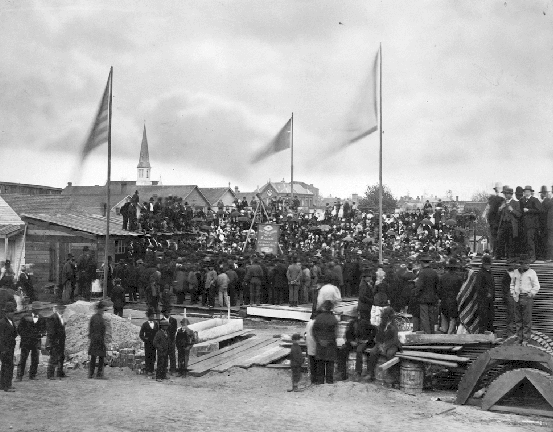Ceremonies
In Victoria’s Victoria, the Freemasons and other membership-based organizations created a sense of community within the middle class that was based on a set of shared values.1 Just as their American cousins had no trouble constructing a history worth celebrating out of their short nationhood, Victoria’s Victorians saw themselves as the authors and heroes of history in the establishment of the colony.2 The settler community was small, local heroes and political movers liked public attention, and the bonds between the few respectable “men” in Victoria were strong. The programs for cornerstone laying ceremonies read like a local street map, including the names of people like James Douglas, Eli Harrison, and Matthew Bailley Begbie.
The laying of the cornerstone for the Independent Order of Odd Fellows Hall in Victoria in 1879.
Prominent men and women could also afford to make large contributions to the building project. The buildings examined in this site are the product of financially hungry building projects and raising the money to begin construction represented an achievement in itself. Everyone who contributed was invited. The ceremonies were also announced and reported on publicly.In any membership-based organization, the implication is that people were also excluded. The Catholic Church, and various Protestant denominations used many ceremonies that served to make their members feel united and protected from “the profane world outside the temple.”3 The politics of inclusion and exclusion are not so clear-cut in early Victoria. James Douglas, for example, sent his daughters to Saint Ann’s Catholic school, but participated in multiple Protestant functions and ceremonies. Prominent figures could slide across religious lines to partake of the festivities, but most of Victoria’s middle class considered themselves prominent. And why shouldn’t they?
On the other hand, there were few, if any, indigenous people at any of the ceremonies covered in this site. Was this because of the distinctly colonial nature of the cornerstone-laying ritual? In religious cornerstone laying ceremonies in parts of the province where missionaries had found many converts, indigenous people participated in large numbers, but photos of cornerstone laying ceremonies in Victoria show few identifiably indigenous people. One explanation might be that in more remote areas of British Columbia the presence and conversion of indigenous people funded the missionaries’ projects. Indigenous people Indigenous people used the churches and institutions within the city of Victoria, but a larger settle population changed the demographics of the building project. The individual contributors often lived in the city and these ceremonies celebrated reaching particular financial goals to raise substantial buildings.
In a Victoria, with a stable population of less than 21,000,4 thousands contributed to community building projects and thousands arrived en mass to catch a glimpse of the stone mason laying the “first” stone. This stone was symbolic, but generally not the first one laid (see cornerstones). Often, especially in catholic ceremonies a list of people who subscribed or made large financial contributions was included in the time capsule laid the same day.






